 |
| March 26, 2013 | Volume 09 Issue 12 |
Designfax weekly eMagazine
Archives
Partners
Manufacturing Center
Product Spotlight
Modern Applications News
Metalworking Ideas For
Today's Job Shops
Tooling and Production
Strategies for large
metalworking plants
Engineer's Toolbox:
Flow simulation and the $75 exhaust header question
 By Robert Warren,
By Robert Warren,
Elite Application Support Engineer,
3DVision Technologies
Is it worth the extra $75 for a long-tube vs. a short-tube exhaust header?
Let's start answering this by examining how an exhaust header works, and why you would want one. Headers are one of the easiest bolt-on accessories you can use to improve an engine's performance. The goal of headers is to make it easier for the engine to push exhaust gases out of the cylinders.
To further understand why the exhaust manifold has an impact on performance, let's review the combustion cycle of a gasoline engine.
1. The intake stroke. Starts with the piston at the top of the cylinder. As the piston moves downward the intake valve opens, allowing the air/fuel mixture to enter the cylinder.
2. The compression stroke. Moves the piston back up to compress this air-fuel mixture, causing the ignition of the air/fuel mixture to be more powerful.
3. The combustion stroke. When the piston reaches the top of the cylinder, the spark plug emits a spark to ignite the gasoline. The gasoline charge in the cylinder explodes, driving the piston down.
4. The exhaust stroke. Once the piston hits the bottom of its stroke, the exhaust valve opens and the exhaust leaves the cylinder to go out the header.
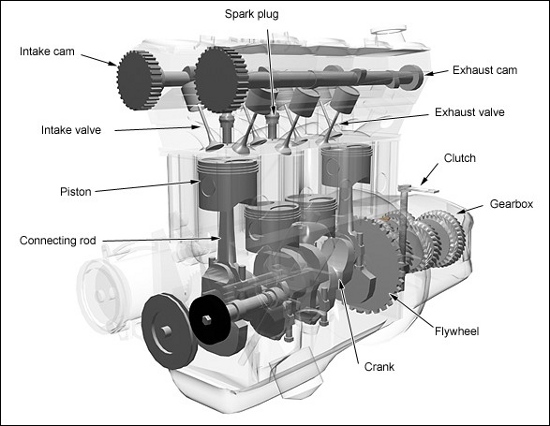
During the exhaust stroke, back pressure robs the engine of power. The exhaust valves open at the beginning of the exhaust stroke, and then the piston pushes the exhaust gases out of the cylinder. The more resistance there is to the piston expelling the exhaust gases, the greater the power loss.
Once the exhaust gases exit the cylinder, they end up in the exhaust manifold. In a four-cylinder engine, all cylinders utilize the same manifold. From the manifold, the exhaust gases flow into one pipe toward the catalytic converter and the muffler. The idea behind an exhaust header is to eliminate the manifold's back pressure. Instead of a common manifold that all of the cylinders share, each cylinder gets its own exhaust pipe. Old hot-rodder intuition, gut feel, and experimentation lead to each pipe being the same length, and using a two-into-one set up. Two-into-one specifies that the pipe leading from two cylinders merges into one. In the case of a four-cylinder, pipes from cylinders 1 and 2 lead to one pipe, and pipes from cylinders 3 and 4 lead to one pipe. Those two pipes then merge again into the collector. The two-into-one method "smooths" the flow through the pipe, causing less turbulence when the flow fields merge. These pipes come together in a larger pipe called the collector. By making them the same length, it guarantees that each cylinder's exhaust gases arrive in the collector spaced out equally, so there is no back pressure generated by the cylinders sharing the collector. Basically, Header = Power, and we all want more power.
The $75 question arose from my sister. She is considering replacing her stock exhaust manifold with an after-market header, and was wondering what was the best "bang for the buck." After researching the topic extensively, we found that across all the after-market brands the designs seemed to be the same regarding pipe routing, materials, etc. So the main question came down to should she buy the "short-tube" or "long-tube" header?
Both the long-tube and short-tube headers have equal-length pipes from the engine block to the collector. Both ran a two-into-one method. The long-tube header description, however, claims that since it is longer by design, there would be less back pressure due to a smoother flow. The differentiator was about $75 -- and the fact that the long-tube header would need the catalytic converter to be moved and remounted by a muffler shop. The short-tube header is a direct bolt-in model.
I couldn't resist turning to SolidWorks Flow Simulation to solve this question.
We purchased the long- and short-tube headers, and we removed the stock manifold to be able to accurately take measurements from them. The models are close but not exact without a reverse-engineering tool, such as a scanner or arm.
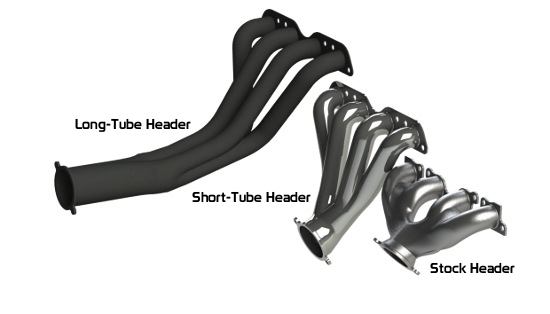
After the models were completed, the next step became the boundary conditions. I was able to find a good reference guide located online from www.donaldsonexhaust.com. Given the engine horsepower, cubic-inch displacement, and operating RPM, I was able to determine intake airflow and exhaust gas flow in cubic feet per minute (CFM).
This calculated the exhaust gas CFM to be 520.00 CFM, or 130.0 CFM per port. Please see the hand calculations below.
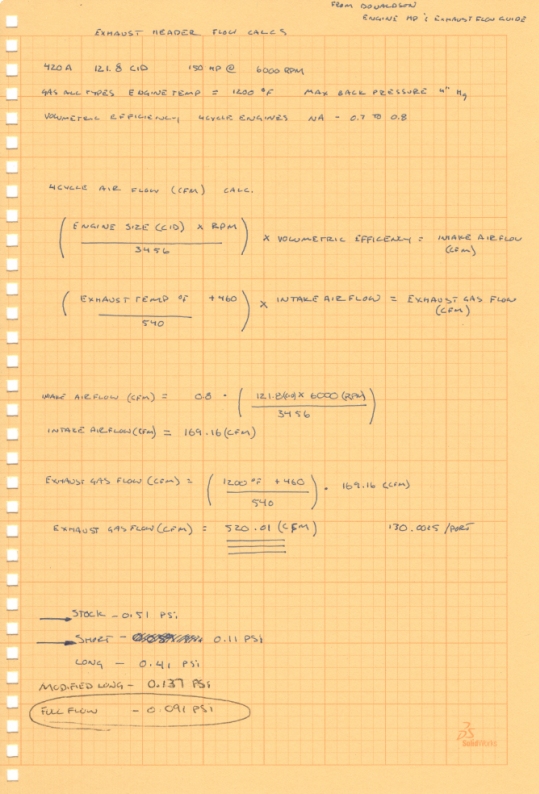
(Yes, engineers still do hand calcs.)
Knowing the CFM of the exhaust leaving the cylinder allows us to compare pressure drop from the inlet to outlet across the three manifold models. The stock exhaust will be the baseline for comparison.
Model setup
- Inlet Condition: 130 CFM per inlet port
- Outlet Condition: Environmental Pressure
- Surface Goals: Each Inlet Goal - Static Pressure / Mass Flow Rate
- Outlet Goal - Static Pressure / Mass Flow Rate
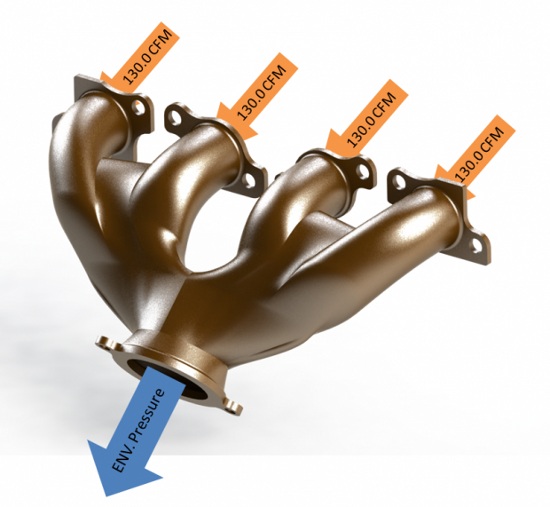
Results:
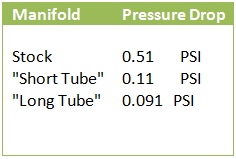
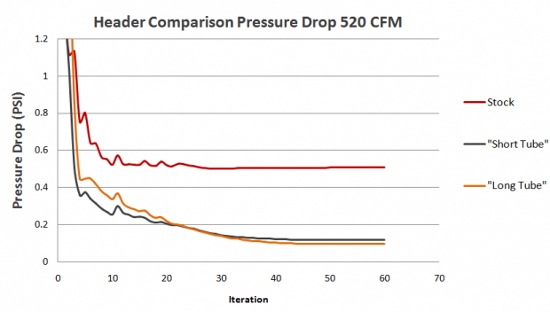
Stock Pressure Gradient
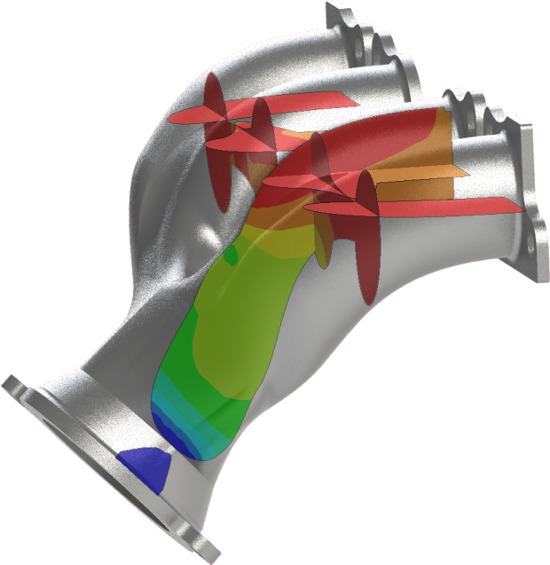
Stock Flow Path
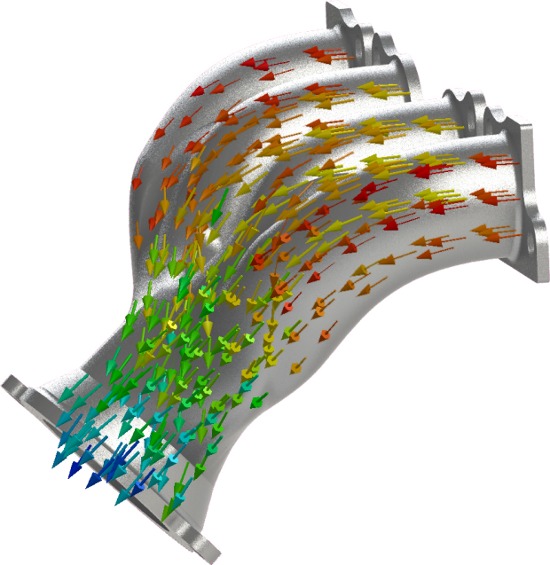
Short-Tube Pressure Gradient
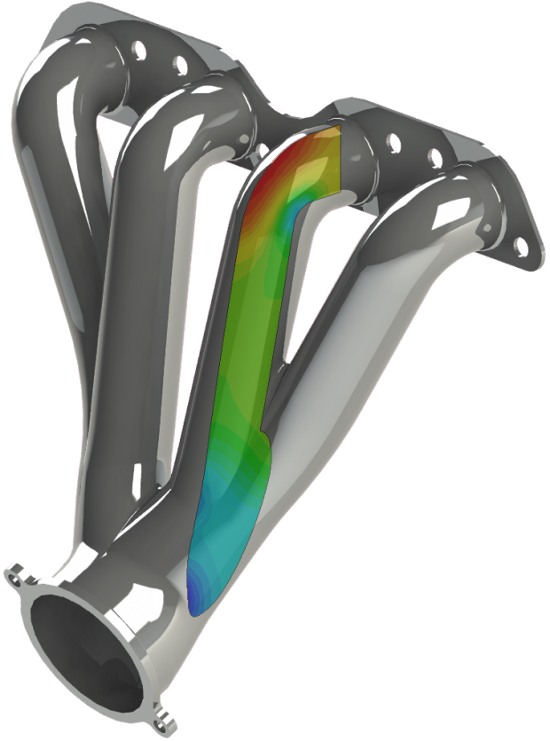
Short-Tube Flow Trajectories
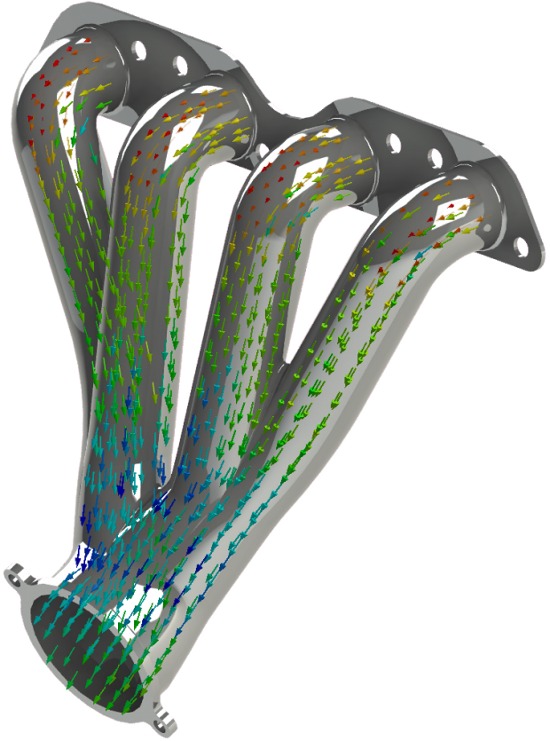
Long-Tube Pressure Gradient
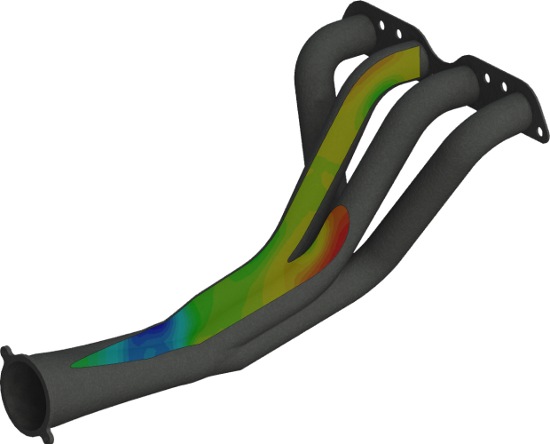
Long-Tube Flow Trajectories
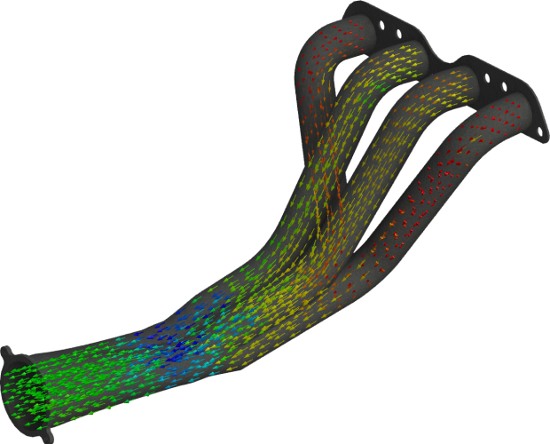
Summary
The short-tube header is hands down the best value.
Both after-market headers showed a drastic decrease in pressure drop over the stock manifold. However, the long tube only had an edge over the short-tube pressure by 0.019 PSI.
As a bonus, the short tube is a direct bolt-in, not requiring the existing catalytic converter to be moved. And, as mentioned, it's $75 cheaper.
As engineers, we are always worried about time and money, and we are often faced with a decision regarding these two factors. From my engineering background and proof provided by flow analysis, I recommended the short-tube header.
About 3DVision Technologies
3DVision Technologies Corp. is the leading value-added reseller of SolidWorks 3D CAD software in Ohio, Kentucky, and Indiana. Read more great blogs, tips, and design tricks from 3DVision Technologies by clicking here.
Published March 2013
Reader comments: Readers identified by first two letters of email only.
JO: I have always had the same question, and great difficulty sorting through the ambigious marketing info. Thanks
MC: Exhaust is not steady state flow. Header length is about tuning pressure waves, not only about pressure drop.
GR: Your analysis is interesting but incomplete in two regards. First, exhaust gas flow is not continuous but pulsing, flowing for only about 1/4 of the time (when exhaust valve is open). So flow rates will peak at much higher velocities. The second dynamic is over various engine RPM. A possible third factor is the length of tubing may resuly in a "scavenging" effect, at various RPM/Tube length - the pulse of exhaust from cylinder 1 will possibly resuly in a low pressure pulse at the valves of cylinder 2 (Bernoulli effect). This will happen at different RPMs for different tube lengths. Without calculating this effect I'm not quantitative, but in effect, longer tubes will give better exhaust flow starting at lower RPMs, resulting in more power benefits at lower RPMs, and possibly peaking at certain frequencies (RPMs).
JK: Wouldn't you really need to run a transient solution to accurately determine the best solution?
PH: In the "day" (50's- 70's) headers were used to TUNE the exhaust system to maximize horsepower in a selected RPM range. Previously exhausted flow caused negative pressure at the exhaust valve for the next exhaust pulse, thus "sucking" the exhaust out and increasing HP in the tuned RPM range. This analysis did not account for that tuning effect
JD: From experience, long tube headers improve both torque and mileage. Short tube headers may be $75 cheaper initially, but eventually more costly due to lower MPG.
MC: The flow and back pressure are interesting comparison numbers. The modeling is an invaluable tool that helps w/ understanding how things work. Header design is much more complicated than just length. Long tubes provide better low speed performance, this means more torque off the line, better for the daily driver. FYI Nascar Cup collectors are located near the output of the transmission, significantly longer than most headers. The Cup headers have been optimized and perfected after countless dyno tests. Thanks for the article.
CH: I enjoyed the article and was flashing back to drag racing days long ago. Near the traps at the far end, I would want the slight advantage of the long tube headers. Day-to-day, the short tube would be fine. "Speed costs money. How fast do you want to go?"
DI: This is all well and fine, but the details matter. For example I've had two sets of shorties (as well as stock and long tubes) - the cheap ones had a really lousy "lip" inside the exit flange which creates all kinds of turbulence (there goes your neat laminar flow assumption) while the good ones had a perfectly smooth exit. And your simulation appears to be based on a continuous-flow notion while long tube headers' value is in resonant exhaust extraction from the pulsed nature of exhaust gas flow. Back pressure in-the-moment may be negative and the upshot is more than simple flow losses - cylinder extraction and charge quality are improved, quite a bit at the peak of effectiveness. For those unfortunate enough to be "smog serfs" it's all moot because you're not allowed to relocate the catalytic converters regardless of any facts.
DL: Unfortunately this article did not take into account what happens in the real world of the exhaust manifold/header actually running on the engine. He only took into account the estimated cfm flow of each cylinder at a single RPM, yet cars operate at a wide RPM band and the 5000 rpm that he used is only attained occasionally, if ever, depending on driving habits. Additionally there are many other factors that come into play, including cam overlap, the scavenging effect of the negative pulse wave from the other cylinders, the effect the remainder of the exhaust system has on the exhaust pressures and pulses within the manifold, or even the two different pressure waves that occur inside the manifold when the exhaust valves first opens - one that is travelling at around 350 ft per second and the pressure wave that is around the speed of sound. There was just so much information ignored that this really was not a valid conclusion or test. I will, as an exhaust header designer by trade agree that in this case the short header was the best value (not to mention the long tube would probably violate emissions laws), but Not for the reasons stated here.
Rate this article
View our terms of use and privacy policy
